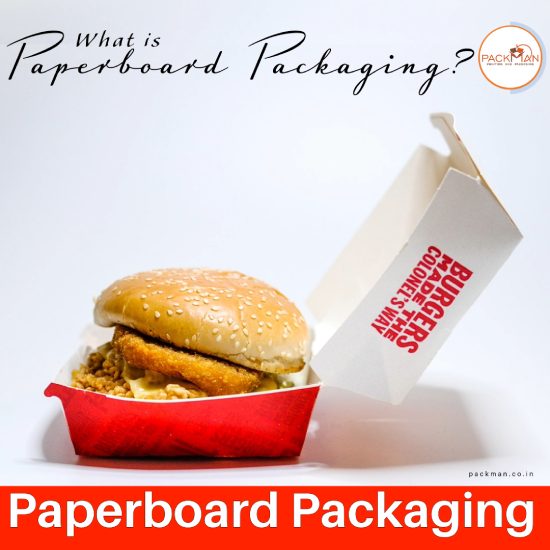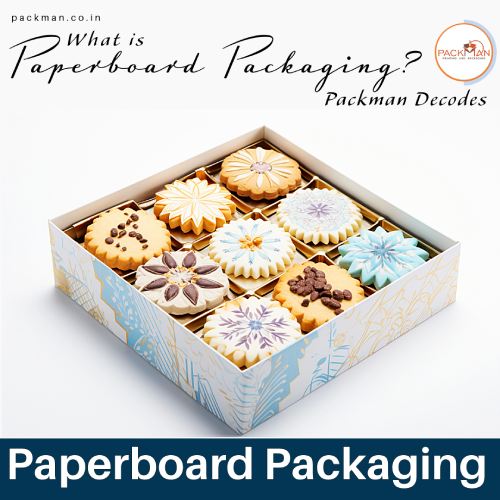In recent times, the packaging industry has witnessed significant growth propelled by the substantial surge in e-commerce activities. The rapid growth of online shopping has emerged as a key catalyst for the packaging sector. As a growing number of consumers embrace digital retail experiences, there is an increase in demand for packaging solutions that offer durability and protection to ensure the safe transit of products.
Businesses are becoming increasingly aware that packaging plays an important role in protecting products and also serves as a potent branding tool. There are various types of packaging available in the market today.
Packman Packaging, the leading corrugated boxes and paperboard packaging manufacturer in India is going to discuss paperboard packaging in this article.

How Paperboard was born?
In the 19th century, advancements in papermaking led to the emergence of paperboard packaging. By the mid-1800s, technology produced robust paper, known as paperboard. Industrialization in the late 1800s and early 1900s spurred cost-effective packaging. Jeweler Aaron L. Dennison pioneered rigid boxes in 1839, diversifying into various products by 1850. Folding cartons, introduced later, provided a flat shipping alternative to upright rigid boxes.
Paperboard is created by layering multiple sheets of paper together. It’s known for being rigid and thick, typically thicker than 0.30 millimeters. Despite its thickness, it can be folded and creased to take on various shapes. Thinner paperboard is used for things like signs and sales materials, while thicker ones are more suitable for shipping and storage.
Paper and paperboard are similar, but paperboard is typically thicker, around 12pt or more. It’s strong and lightweight, making it ideal for packaging. Paperboards, with thicknesses from 0.2 to 1.0 mm, are key materials for containers like cartons and cups. Coated boards are widely used. The weight per area ranges from 120 to 700 g/m2. Thicker paperboards are made by combining multiple layers, offering advantages through varied raw material blending.
What are the Types of Different Grades of Paperboard?
Solid Bleached Sulfate (SBS), also known as bleached paperboard, is a high-quality material crafted from over 80% virgin bleached wood pulp. Frequently coated with kaolin clay for enhanced printability and polyethylene resin for wet strength, SBS is widely utilized in premium packaging. Its applications span various sectors, including medical, cosmetic, and candy packaging, as well as stand-up displays.
Coated Unbleached Kraft (CUK) Board, derived from unbleached kraft pulp, boasts improved printing and packaging capabilities. With a natural brown appearance ideal for eco-friendly aesthetics, CUK Board is commonly used in heavy-duty packaging, frozen food, beverage containers, and pharmaceutical packaging due to its strength and sustainability. Variations like Clay Natural Kraft (CNK) further expand its versatility.
Coated Recycled Board (CRB), also known as Clay Coated Newsback (CCNB), is an eco-friendly option made entirely from recycled paperboard. Coated with a thin layer of kaolin clay, CRB excels in soap and detergent packaging, paper goods, cereal cartons, light bulbs, and FDA-compliant dry food packaging.
MET-PET Board seamlessly combines the SBS paperboard with a metalized polyester film, providing superior barrier properties and a metallic luster. Ideal for premium packaging in media, medical, pharmaceutical, signage, and display sectors, the MET-PET Board ensures both visual allure and protective efficacy.
Benefits of Paperboard packaging
Versatility: Paperboard’s utility depends on thickness, with thin variants suitable for point-of-sale materials and thicker ones ideal for fragile, heavier products like boxes and trays.
Durability: Thicker than paper, paperboard provides extra support and can be strengthened by laminating piles with PVA water-based glue, offering a customizable level of durability.
Environmentally-Friendly: Paperboard is a sustainable and recyclable material, sourced ethically from sustainable environments. It helps businesses reduce their carbon footprint by replacing plastic with an eco-friendly alternative.
Scalability: Whether in rolls, sheets, or tubes, paperboard offers scalability to accommodate various business sizes. This flexibility allows for efficient scaling up or down, reducing waste and offering a cost-effective packaging solution.
What are the Uses of Paperboard packaging?
Paperboard serves diverse industries, including food, retail, and pharmaceuticals.
- Food: Used for cereal boxes, milk and juice cartons, cake, and frozen food packaging.
- Retail applications include perfume, cosmetics, game boards, toys, and toiletries packaging.
- Pharmaceuticals: used for prescriptions, over-the-counter drugs, hospital supplies, and postage.
Now that you know the rich history, grades, benefits, and versatile applications of paperboard packaging, it’s evident that this sustainable, durable material is the cornerstone for eco-friendly, scalable, and innovative packaging solutions across various industries.




